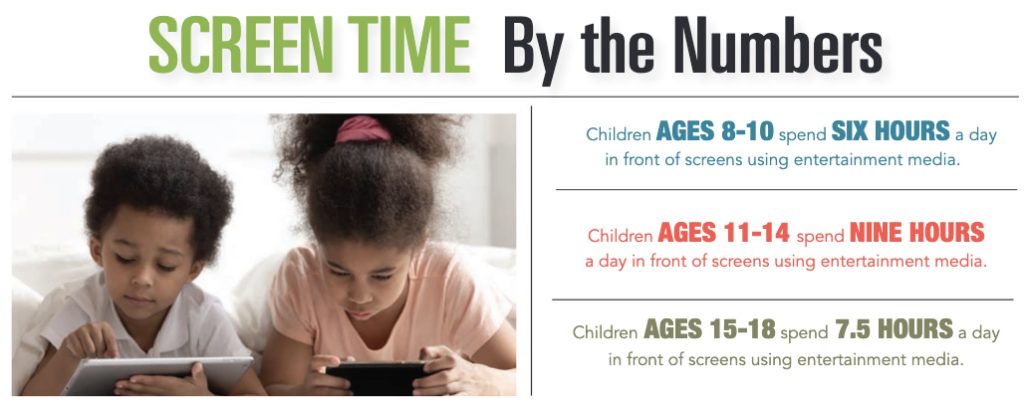We live in an age in which texting, messaging apps and social media platforms such as Instagram and Facebook allow us to share every movement and every moment of our lives. While this connectivity is now firmly woven into the fabric of how we function as a society, there is a question of how much is too much, especially for a generation of children who have never existed without screen time being part of their day.
“There is a definite Pavlovian response,” Michelle Liechty, certified nurse practitioner at Coastal Pediatric Associates in Mount Pleasant, agreed. “There’s a reward every time someone interacts with their phone. When you see a like notification from Facebook or a Snapchat notice, it triggers a dopamine release that leaves you with a feeling of reward. You now have the drive to continue to look at your phone every time you hear that bell.”
Many apps and games are designed to keep people hooked, and people in certain age groups are exceptionally vulnerable.
“Kids and teens have a strong need to belong and feel accepted – to feel part of a group. These apps play to those needs. Snapchat, for example, originally started off as quick interactions: photos or short videos that disappear after a short time. They then introduced the Best Friend feature, where you are publicly recognized as another user’s best friend. Then came the Snapstreak feature, where interaction through the app became almost a game,” Liechty said.
“The message kids are getting is ‘Don’t break your streak.’ So even if a child is, say, on a hike with their parents, that phone might be in their pocket, and they feel urgency to take it out and open the app, all in the name of keeping their streak,” Liechty added.
There is no official recognition of smartphone addiction in the Diagnostic and Statistical Manual of Mental Disorders, which is used to formally classify mental health disorders, but it is, according to Psychiatry Advisor’s “Criteria for Identification of Smartphone Addiction,” “ . . . increasingly recognized as a type of behavioral addiction.”
Striking a balance between figuring out a way for your children to function in the here and now while allowing them to enjoy an online life might be difficult. However, it’s important to make the effort, according to Liechty, because sleep disturbances often are linked to too much screen time.
“One of the biggest issues I’ve seen with overuse of smartphones and other devices is a decrease in the amount of sleep children are getting during normal sleep hours. A child presents complaining of tiredness during the day or, especially during the summer, a child might oversleep,” said Liechty. “What we often discover is that there is a discrepancy between bedtime and the hour at which a child falls asleep. Parents’ jaws hit the floor when they discover that their child may go to bed at 9:30 but doesn’t actually fall asleep until 2 a.m. or 4 a.m.”
“There is a biological process to falling asleep,” Liechty added. “We disrupt that process by the blue-light exposure of our screens dampening the release of our body’s sleep hormone, melatonin. The disruption of that process makes it harder to fall asleep, which makes it harder to wake up. Sometimes, parents will come in concerned about a child’s school performance or ability to focus. Within those visits, we dig a bit deeper and often discover that too much screen time in the evening coupled with poor sleep is the culprit.”
Trying to keep kids engaged in other activities so they aren’t swallowed up by their smartphones or other mobile devices can be a challenge. Many parents find it difficult to adhere to hard and fast screen time rules.
Cody Fritz of Greenville has three sons under the age of 12. He and his wife, Erin, have worked to try to get ahead of the issues that come with too much tech.
“We’re aware of the pitfalls of screen time abuse, but we don’t have a schedule set in stone,” Fritz said. “For us, it’s easier to judge it on the tempo of the household. If something else needs to be happening, the screens go off: gaming consoles, televisions, iPads and Mom and Dad’s phones all get put away. The amount of time spent gaming, or whatever, depends on behavior. If all is going well, they get to play longer. If I assess that someone is having an unreasonable reaction to a game or app, off it goes.”
“During the school year and on the weekends, the only rule is that you must be prepared for the day to start before screens go on and that includes the television. Teeth have to be brushed and you have to be dressed,” Fritz laughed.
The Fritz family adjusts during the summer, when the structure of a classroom isn’t part of the boys’ day.
“We’ve developed a system where the boys collect points to, well, not earn screen time per se, but earn free time for themselves, including iPad, gaming or phone time,” Fritz explained. “We have five categories where points are earned: physical, which is exercise, yard work or chores; mental, where they read, learn something new, study a subject or get lost in their own thoughts, as long as they write those thoughts down; spiritual, for church attendance or time spent praying; charity, for volunteering for either formal charities or outreach programs; and fellowship points, earned by meaningful interaction with friends and other people. Once enough points are earned, their time is theirs. If they choose screen time, I’m OK with that because they’ve at least spent time developing skills we believe are healthy and important. By going this route, screen time becomes a fun, useful tool that happens to be a small part of a bigger life instead of feeling like it’s their whole life.”
That loosely structured set of rules may work for some children, while others might need more definitive boundaries. Liechty suggested that parents utilize the American Academy of Pediatrics recommendations as a guide:
- 0 – 18 months, no screen time;
- 18 – 24 months, no screen time unless video chatting with family;
- Until the age of 6, an hour or less a day of educational use with parental interaction;
- Ages 6 and above: monitoring time and content.
There are supportive resources available if you feel that your family is struggling with managing time and content. Websites such as connectsafely.org/family-contract-smartphone-use offer helpful information including family contracts for smartphone use, safety tips and resources for youth in crisis.
Signs of Addictive Behavior
- Intense urgency to use your phone or other device;
- Spending more time on devices than was first intended;
- Neglecting other more important things in favor of the device;
- Continued use of any device, despite knowing it could have negative effects on other areas of your life, including sleep or schoolwork.
By Amy Gesell








